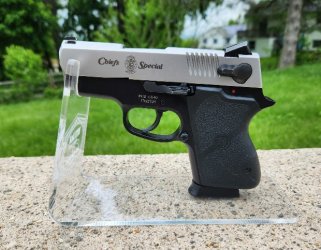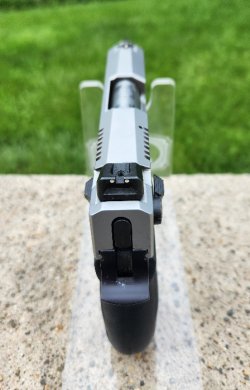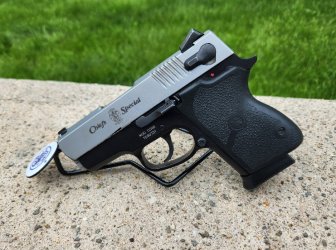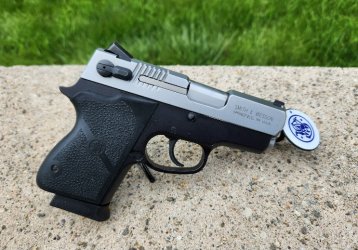Fixing the freebore/leade problem in the CS40
.
Having received the ordered Manson 40/10 throater I next decided on a means to help facilitate the task & what dimension to use for the CS40's barrel.
Since the Zero 165gr & 180gr JHPs are the bullets I use the most for range & casual shooting, & their profiles (which are the same) are most prone to contacting the rifling in barrels with insufficient leade/freebore when seated out to SAAMI max COAL (1.135"), I made two "bullet gages" using the 165gr JHP bullets.
One I seated normally with the nose out (A). The other reversed with the nose in the case & it's base out (B).
To determine a logical real world seating depth for each gage I looked at my spec notes containing critical dimensions & clearances I measure for each new/used pistol I buy. (I found in the past this documentation usually ends up being useful later plus you can often find problems before shooting like barrel constrictions, B-C gap issues, chamber/throat issues, etc. Yes, I go a little overboard.

)
I picked a 4013, a pre-rail 4013TSW & a pre-rail 4056TSW to use to arrive at a happy medium for the seating depths. The large frame 4013 had the most generous factory leade/freebore while the other two medium frame 40s were close on the tighter side with the 4056TSW a tad tighter.
While my leade/freebore measurements are repeatable there's some variance possible because the pin gages I use are precise in their diameters & uniformity but for some reason their lengths are not all cut perfectly square to their diameter which causes some variations when using them in this way. They weren't intended for this use since they're sold as diameter gages, not length gages but I have to use both aspects of the pin gages to calculate the final reading.
For gage (A) I went with a COAL of 1.145" (.010" over SAAMI max) which all three barrels plunked fine with. (The 4013 could plunk up to 1.223" before contacting the rifling!

)
For gage (B) I decided on a COAL of 0.992" which leaves ~.151" of the bullet's base outside the case. Again the 4013 easily swallowed this length & the other two just clearing it.
The base on these Zero bullets have a fairly square corner, more so than other name brand bullets that I checked. I felt that was a beneficial asset here.
The bullets were initially seated in unprimed sized cases & taper crimped to remove any case flaring after partial seating. Then I slowly seated the bullets while checking COAL & testing in the three barrels until the desired measurement was reach & confirmed & taper crimped again.
The pics below show gage (B) fully seated in the 4013's chamber while in the CS40's chamber it's no where close to being seated due to the lack of any freebore.
I took pics of the CS40's chamber from a left & right angle to show how the leade/freebore looks. From the left angle you can see a strange cut/groove partially up the leade. This barrel definitely got gypped at checkout. Maybe because it was in the Value Series lane?

From both angles you can clearly see the rifling's leade (the cut angle) extends to the edge of the CS40's chamber shoulder. The factory cut 4013 pic shows a clear smooth freebore between the chamber shoulder & the start of the rifling's leade. All my 3rd Gens look like this with the exception of my 4040PD which is slightly less defined but still plunked these gages without any interference.
Finally at the workbench the CS40 barrel is secured horizontally, muzzle slightly down, in the padded vise & with plenty of cutting oil I slowly start cutting by hand. Manson says the throaters work best when they have to remove some throat diameter while being inserted, I suspect for alignment.
What you feel getting cut first is the throat's smooth resistance. Once you're thru the throat you're quickly into the rifling, cutting the leade angle which is definitely rougher on the hand & anything but smooth.
A pistol or barrel throater is slightly different than a revolver or cylinder throater. The pistol throater cuts the throat & leade while centered on the barrels bore with it's pilot. The revolver throater only has to cut the cylinder's throats while trying to keep centered on the exit throat. Neither touches or cuts into the chamber's existing dimensions.
Once finished the barrel was thoroughly cleaned of the cutting oil & given a light coat of preservative oil down the barrel.
The leade/freebore now measures .132" (from virtually nothing) & both gages plunk properly. The throat diameter changed from an unusually tight .3985" (no doubt because it really didn't have a throat due to the leade running to the shoulder) to .4025".
I hate having to load special ammo for a particular gun versus what it siblings get. Now I don't have to with the CS40 anymore.

Next stop the range to shoot some 1.135" handloads in it.
.

.
.

.
.

.
.

.
.

.
.

.
.

.
.

.
.

.
.

.


















